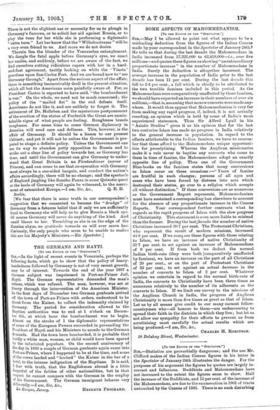SOME ASPECTS OF MAHOMMEDANISM.
[To THR EDITOR OF THE "SPECTATOR"]
Srs,—May I be allowed to point out what appears to be a misleading deduction from the figures of the Indian Census made by your correspondent in the Spectator of January 24th P He tells us that during the last decade the Mahommedans in India increased from 57,321,000 to 62,458,000—i.e., over five millions—and quotes these figures as showing " an extraordinary proportionate increase" in the number of Mahommedans in India. Surely the deduction is altogether incorrect. The average increase in the population of India prior to the last decade has been 11 per cent. During the last decade this fell to 2.4 per cent., a fall which is chiefly to be attributed to the two terrible famines included in this period. As the Mahommedans were comparatively unaffected by these famines, we should have expected an increase in their numbers of over six millions,—that is, assuming that no new converts were made any- where. It would thus appear that Mahommedanism is very far from making any rapid progress, if, indeed, it is not actually receding, an opinion which is held by some of India's most experienced statesmen. Thus Sir Alfred Lyall in his• "Asiatic Studies" gives it as his opinion that for the last two centuries Islam has made no progress in India relatively to the general increase in population. In regard to the effects attributable to the Indian famines, we have to remem- ber that these afford to the Mahommedans unique opportuni- ties for proselytising. Whereas the Anglican missionaries make it a rule never to baptise any converts who come to them in time of famine, the Mahommedana adopt an exactly opposite line of policy. Thus one of the Government Blue-books on the famines states that many conversions to Islam occur on these occasions :—" Years of famine are fruitful in such changes; persons of all ages and sexes who have been forced by distress into acts which destroyed their status, go over to a religion which accepts all without distinction." If these conversions are as numerous as the Government Report represents, Afahommedanism must have sustained a corresponding loss elsewhere to account for the absence of any proportionate increase in the Census, Reports. Your correspondent further contrasts what he regards as the rapid progress of Islam with the slow progress of Christianity. This statement is even more liable to mislead than the former. During the last:decade the number of native Christians increased 30.7 per cent. The Protestant Christians, who represent the result of modern missions, increased 44.8 per cent. If we compare these figures with those relating to Islam, we have an increase of native Christianity of 311 per cent. to set against an increase of Mahommedans of 9 per cent. If from both we deduct the normal Indian birth-rate (they were both (comparatively unaffected by famines), we have an increase on the part of all Christians of 20 per cent., or on the part of Protestant Christians of 33 per cent., to set against an actual decrease in the number of converts to Islam of 2 per cent. Whatever opinion we entertain in regard to the normal birth-rate of India, the converts to Christianity have been three times as numerous relatively to the number of its adherents as the converts to Islam. If we limit our survey to the missions of the Anglican Church in India, the progress of Anglican Christianity is more than five times as great as that of Islam. Let us by all means give credit to our many earnest fellow- countrymen who—all honour to them—are endeavouring to spread their faith in the districts in which they live ; but let us not allow our sympathy for their efforts to prevent us from scrutinising most carefully the actual results which are being produced.—I am, Sir, &c.,
CHARLES H. ROBINSON. 19 Delakay Street, Westminster.






















































 Previous page
Previous page